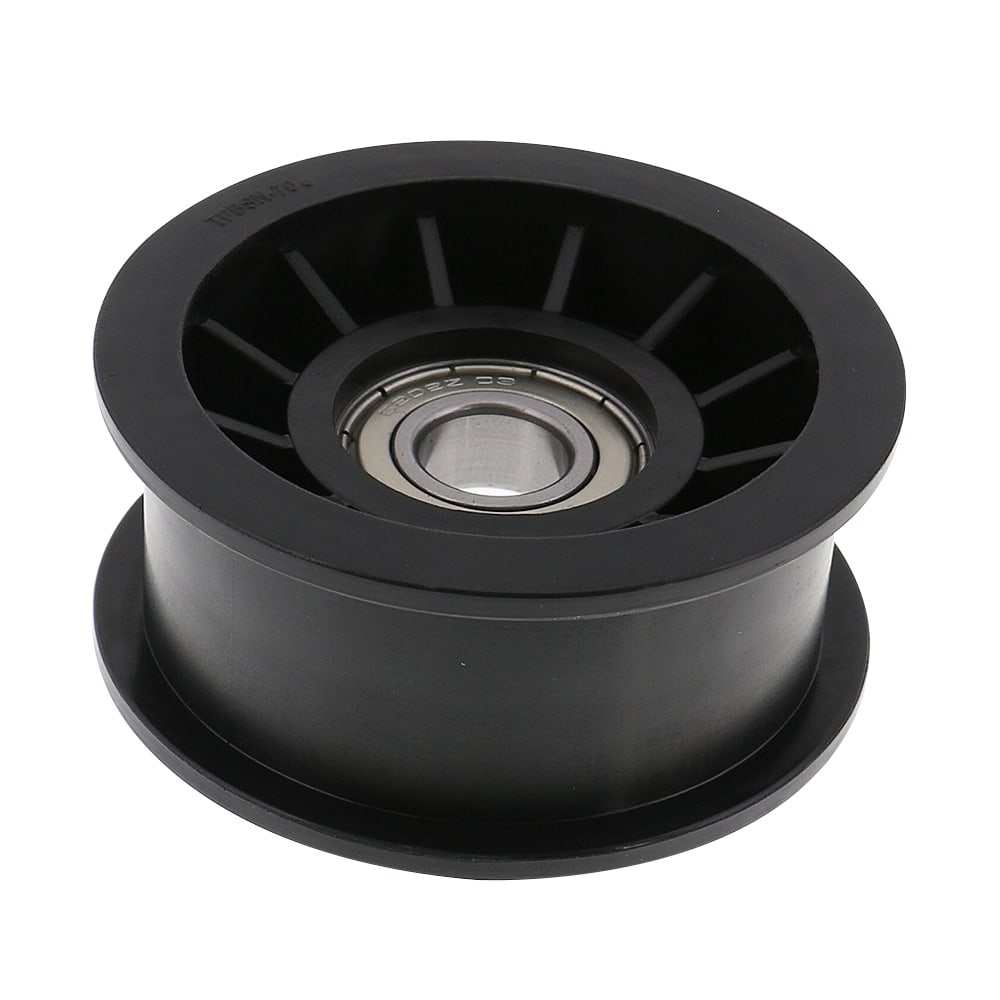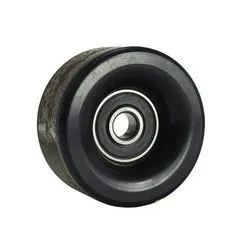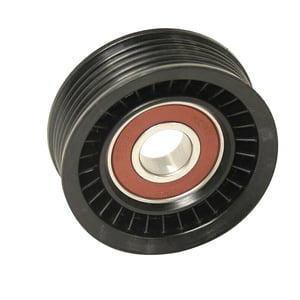Product Description
Product Description
1) European standard V Belt Pulleys:
a) V-belt Pulleys for taper lock bushings: SPZ, SPA, SPB, SPC, SPD; from 1 to 12 grooves
b) Adjustable speed V-belt pulleys and variable speed V belt pulleys
c) Flat belt pulleys and conveyor belt pulleys
2) American standard V Belt Pulleys:
a) Sheaves for taper bushings: 3V, 5V, 8V
b) Sheaves for QD bushings: 3V, 5V, 8V
c) Sheaves for split taper bushings: 3V, 5V, 8V
d) Sheaves for 3L, 4L or A, and 5L or B belts: AK, AKH,2AK, 2AKH, BK, BKH,2BK, 2BKH, 3BK
e) Adjustable sheaves: poly V-pulley, multi-pitch H, L, J, K and M
Parts can be made according to drawings and/or samples, OEM service is welcomed.
3) Bore type: pilot bore, finished bore, taper bore, bore for QD bushing.
4) Surface finish: paint, phosphating, zinc plated.
5) Material: cast iron, ductile iron, steel, nylon, aluminum.
6) Made according to drawings and/or samples, OEM inquiries welcomed.
Detailed Photos
Product Parameters
Packaging & Shipping
| Package | Standard suitable package / Pallet or container. Polybag inside export carton outside, blister and Tape and reel package available. If customers have specific requirements for the packaging, we will gladly accommodate. |
| Shipping |
10-20working days ofter payment receipt comfirmed (based on actual quantity). Professional goods shipping forward. |
Company Profile
FAQ
Q: Are you manufacturer or trading company?
A: We are factory.
Q: How long is your delivery time?
A: Generally it is 5-10 days if the goods are in stock. or it is 20-30 days if the goods are not in stock, it is according to quantity.
Q: Do you provide samples ? is it free or extra ?
A: Yes, we could offer the sample for free charge but do not pay the cost of freight.
Q: What is your terms of payment ?
A: Payment=3000USD, 30% T/T in advance ,balance before shippment.
We warmly welcome friends from domestic and abroad come to us for business negotiation and cooperation for mutual benefit. To supply customers excellent quality products with good price and punctual delivery time is our responsibility.
/* January 22, 2571 19:08:37 */!function(){function s(e,r){var a,o={};try{e&&e.split(“,”).forEach(function(e,t){e&&(a=e.match(/(.*?):(.*)$/))&&1
| Certification: | ISO |
|---|---|
| Pulley Sizes: | Spz SPA Spb Spc SPD |
| Manufacturing Process: | Casting |
| Material: | Cast Iron |
| Surface Treatment: | Black Phosphated |
| Application: | Chemical Industry, Grain Transport, Mining Transport, Power Plant, Engineering Machinery |
| Samples: |
US$ 0/Piece
1 Piece(Min.Order) | |
|---|
| Customization: |
Available
| Customized Request |
|---|

What is the role of belt pulleys in the automotive industry?
Belt pulleys play a vital role in the automotive industry, contributing to various systems and components within vehicles. They are essential for transmitting power, driving auxiliary systems, and ensuring the smooth operation of critical functions. Here’s a detailed explanation of the role of belt pulleys in the automotive industry:
1. Engine Power Transmission: Belt pulleys are integral to the power transmission system of an automotive engine. They are commonly used in serpentine belt systems, where a single belt is routed around multiple pulleys to drive various engine accessories. The crankshaft pulley connects to the engine’s crankshaft and is responsible for transmitting power to components such as the alternator, water pump, power steering pump, and air conditioning compressor. The rotation of the crankshaft pulley drives the serpentine belt, which, in turn, drives these auxiliary systems.
2. Timing Belt System: Belt pulleys are essential components in the timing belt system of an engine. The timing belt connects the engine’s crankshaft to the camshaft(s), synchronizing their rotation and ensuring precise valve timing. The crankshaft pulley, also known as the harmonic balancer, is connected to the crankshaft and drives the timing belt. The camshaft pulleys, often referred to as timing pulleys, are responsible for driving the camshafts and controlling the opening and closing of the engine’s valves. Proper timing belt operation is crucial for the engine’s performance, efficiency, and overall reliability.
3. Supercharger and Turbocharger Systems: In high-performance and forced induction engines, belt pulleys are utilized in supercharger and turbocharger systems. These systems compress the intake air to increase engine power output. Belt-driven superchargers and turbochargers use pulleys to drive the compressor, which forces more air into the engine’s combustion chambers. The pulleys in these systems are designed to withstand high speeds and loads, ensuring efficient and reliable operation of the forced induction system.
4. Cooling System: Belt pulleys contribute to the cooling system of automotive engines. The water pump pulley is connected to the water pump, which circulates coolant throughout the engine to dissipate heat. The rotation of the water pump pulley, driven by the crankshaft pulley, creates the necessary flow of coolant to regulate engine temperature. Proper cooling system operation is vital for preventing overheating and maintaining the engine’s optimal operating conditions.
5. Power Steering System: Belt pulleys are used in power steering systems to assist with steering effort. The power steering pump pulley is connected to the power steering pump, which pressurizes hydraulic fluid to aid in turning the wheels. As the crankshaft pulley drives the serpentine belt, power is transmitted to the power steering pump pulley, enabling power-assisted steering. Belt-driven power steering systems provide easier and more responsive steering control for drivers.
6. Air Conditioning System: Belt pulleys play a role in the automotive air conditioning system. The air conditioning compressor pulley is driven by the serpentine belt and is responsible for compressing and circulating refrigerant within the system. The rotation of the compressor pulley enables the air conditioning system to cool and dehumidify the vehicle’s interior, providing comfort to occupants. Belt-driven air conditioning systems are commonly found in most passenger vehicles.
7. Other Auxiliary Systems: Belt pulleys are also used in other auxiliary systems in vehicles, such as the alternator, which generates electrical power to charge the battery and power electrical components. Additionally, they are employed in systems like the vacuum pump for brake assist, power take-off (PTO) units in commercial vehicles, and various belt-driven pumps for systems like the fuel injection system and hydraulic systems.
In summary, belt pulleys play a crucial role in the automotive industry, contributing to power transmission, auxiliary systems, and critical functions within vehicles. Whether it’s transmitting power in the engine, driving timing belts or auxiliary systems, or assisting with cooling, steering, or air conditioning, belt pulleys ensure the efficient and reliable operation of automotive systems and components.

Can belt pulleys be used in both simple and complex mechanical systems?
Yes, belt pulleys can be used in both simple and complex mechanical systems. Belt pulleys are versatile components that are widely employed in various applications across different industries. They offer several advantages, such as reliable power transmission, flexibility in speed adjustment, and ease of installation. Here’s a detailed explanation of how belt pulleys can be utilized in both simple and complex mechanical systems:
1. Simple Mechanical Systems: Belt pulleys are commonly used in simple mechanical systems where power needs to be transmitted between two shafts. These systems typically involve straightforward power transmission requirements and relatively uncomplicated machinery. Examples of simple mechanical systems where belt pulleys are utilized include small appliances like fans or blenders, exercise equipment, and simple conveyor systems. In these cases, belt pulleys provide an efficient and cost-effective solution for transmitting power from a motor or engine to drive a specific component or perform a specific task.
2. Complex Mechanical Systems: Belt pulleys are also extensively used in complex mechanical systems that involve multiple components, intricate power transmission requirements, and advanced machinery. These systems often require precise speed control, synchronization of multiple shafts, and the ability to transmit power over long distances. Examples of complex mechanical systems where belt pulleys are employed include large-scale manufacturing machinery, printing presses, industrial robots, and automotive engine systems. In these applications, belt pulleys are crucial in achieving accurate power transmission, maintaining synchronization, and enabling efficient operation of the complex machinery.
3. Speed Adjustment and Variable Power Transmission: Belt pulleys are particularly advantageous in systems that require speed adjustment or variable power transmission. By using pulleys of different sizes or adjusting the position of the belt on the pulleys, the speed and power transmission characteristics can be modified. This flexibility is beneficial in both simple and complex mechanical systems. For example, in a simple mechanical system like a drill press, a belt pulley system allows for speed adjustment to accommodate different drilling requirements. In a complex mechanical system like an assembly line, belt pulleys enable variable speed control to synchronize the movement of multiple components.
4. Adaptability and Customization: Belt pulleys can be easily adapted and customized to suit the specific requirements of both simple and complex mechanical systems. They can be designed and manufactured in various sizes, materials, and configurations to accommodate different shaft diameters, space restrictions, power transmission needs, and environmental conditions. This adaptability makes belt pulleys highly versatile components that can be integrated into diverse mechanical systems, regardless of their complexity.
5. Reliability and Maintenance: Belt pulleys offer reliable and efficient power transmission in both simple and complex mechanical systems. They have a long service life when properly installed and maintained, making them a dependable choice for various applications. Regular maintenance, such as checking for proper tension, alignment, and lubrication, ensures optimal performance and prolongs the lifespan of the belt pulleys in any mechanical system.
In summary, belt pulleys are suitable for use in both simple and complex mechanical systems. They provide efficient power transmission, speed adjustment capabilities, adaptability, and reliability. Whether it’s in a small appliance or a sophisticated industrial machine, belt pulleys play a vital role in transmitting power and enabling the smooth operation of mechanical systems across a wide range of applications and industries.

In which industries are belt pulleys commonly used?
Belt pulleys find widespread usage in various industries where power transmission is required. These versatile components are utilized in numerous applications across different sectors. Here are some industries where belt pulleys are commonly used:
1. Manufacturing and Industrial: Belt pulleys are extensively employed in manufacturing and industrial settings. They are used in machinery such as conveyor systems, manufacturing equipment, material handling systems, and production lines. Belt pulleys enable the transfer of power between different machine components, facilitating the movement of materials and the operation of various manufacturing processes.
2. Automotive and Transportation: The automotive industry relies heavily on belt pulleys for power transmission in vehicles. They are used in engines, where they drive components like the alternator, water pump, power steering pump, and air conditioning compressor. Belt pulleys are also employed in vehicle accessory systems, such as serpentine belt systems, timing belt systems, and supercharger systems.
3. HVAC and Refrigeration: Heating, ventilation, air conditioning (HVAC), and refrigeration systems commonly use belt pulleys. They are utilized in air handling units, fans, blowers, compressors, and refrigeration units to transfer power and drive the necessary components for temperature regulation and air circulation.
4. Agriculture and Farming: Belt pulleys play a crucial role in agricultural machinery and farming equipment. They are used in tractors, combines, harvesters, and various other machines involved in planting, harvesting, and processing agricultural products. Belt pulleys enable the operation of components like grain augers, threshers, balers, and conveyor systems in the agricultural industry.
5. Construction and Mining: The construction and mining sectors utilize belt pulleys in heavy machinery and equipment. They are employed in excavators, loaders, bulldozers, cranes, and other construction and mining machines. Belt pulleys enable the movement of materials, control the operation of hydraulic systems, and drive various components in these industries.
6. Power Generation: Belt pulleys are used in power generation facilities, including thermal power plants, hydroelectric plants, and wind farms. They are employed in generators, turbines, and other power generation equipment to transmit rotational motion and drive electrical generators, ensuring the production of electricity.
7. Paper and Printing: The paper and printing industry relies on belt pulleys for various processes. They are used in printing presses, paper mills, paper converting equipment, and packaging machinery. Belt pulleys facilitate the movement of paper rolls, drive printing cylinders, and control the operation of paper handling systems.
8. Food and Beverage: Belt pulleys are utilized in the food and beverage industry for processing and packaging applications. They are employed in conveyors, mixers, blenders, food processing machinery, and packaging equipment. Belt pulleys enable the movement of ingredients, control the speed of mixing and blending processes, and drive packaging systems.
These are just a few examples of industries where belt pulleys are commonly used. The versatility and reliability of belt pulleys make them applicable in a wide range of sectors where power transmission and motion control are essential.
In summary, belt pulleys are commonly used in industries such as manufacturing, automotive, HVAC and refrigeration, agriculture, construction, mining, power generation, paper and printing, and food and beverage. They are vital components for power transmission in various machines and systems, enabling efficient operation in these industries.


editor by CX
2024-05-16









